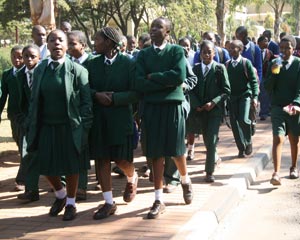
Girls’ education is the single most powerful investment for development. Sunday View by Anna Mutavati
Studies have shown that girls’ education is consistently associated with positive development outcomes such as reduced maternal mortality, smaller families and healthier children.
Additionally, when a mother is educated, intergenerational poverty is broken, children are more likely to be sent to school and infant and child mortality is reduced, among other benefits. Education is one of the most effective strategies for combatting child marriage, especially as girls progress to secondary school. According to a World Bank report, a one percentage point increase in female education raises the average level of GDP by 0,3 percentage points.
According to the Zimbabwe Millennium Development Goals Progress Report for 2012, gender parity has been achieved at primary school enrollment but the trend is not maintained at secondary and tertiary levels. While there is closer gender equality in enrollment in lower secondary school, girls experience higher dropout during key years of Form Three and Form Four (78% of girls drop out in Form Four as opposed to 75% of boys).
At tertiary level, female enrolment rate at universities rose to 43% in 2011, up from only 23% in 2006. Factors behind these disparities include poverty, unplanned teenage pregnancy, early marriage, violence perpetrated in the school and home environment, absence of role models to motivate especially rural school girls, inadequate sanitation facilities for girls, burden of gender roles at home, harmful religious and traditional practices, negative attitudes towards girls’ education and vulnerability to HIV and Aids.
Given all the evidence of potential rewards from girls’ education, it cannot remain business as usual. Innovative approaches are required in all sectors, by all actors at all levels, to harvest the full potential of girls’ full participation in education.
However, simply putting children in school is only the starting point. Issues of the quality of education and pass rates need to be addressed as well, and this is a full subject on its own, which is receiving full attention in other forums.
This forum will focus on the innovation for girls’ education, in line with today’s commemoration. To start with, if girls are dropping out of school due to early/ unplanned/ unwanted pregnancy, the education curriculum needs to be alive to this reality and respond accordingly. Sexual and reproductive health education needs to be part of the learning curriculum, at all levels, in line with the evolving capacities of children.
- Chamisa under fire over US$120K donation
- Mavhunga puts DeMbare into Chibuku quarterfinals
- Pension funds bet on Cabora Bassa oilfields
- Councils defy govt fire tender directive
Keep Reading
It should not be approached as a voluntary activity/ school club but as a mainstream subject in formal children’s learning. Such learning would also equip both male and female learners with life skills to prevent HIV and Aids infection and more specifically reduce girls’ vulnerability.
The ongoing curriculum review should be a perfect entry point for this integration. Additionally, innovative strategies need to be explored for supporting full implementation of government policy on second chance education, to make it work for young school drop-outs.
The school environment needs to be conducive for girls’ learning. Girl-friendly sanitation facilities and supplies should be in place at all schools to support girls’ needs during menstruation.
It is saddening to note that even as world governments conclude the MDG agenda and embarks on a new development framework, girls in both rural and urban schools still have to contend with missing school for a number of days every month because their school sanitation facilities do not address their menstrual needs.
Additionally, the school environment needs to better protect all children from all forms of violence. A recent study by Zimstat shows that 33% of girls aged 18-24 reported experiencing one form or another of sexual violence since their childhood.











